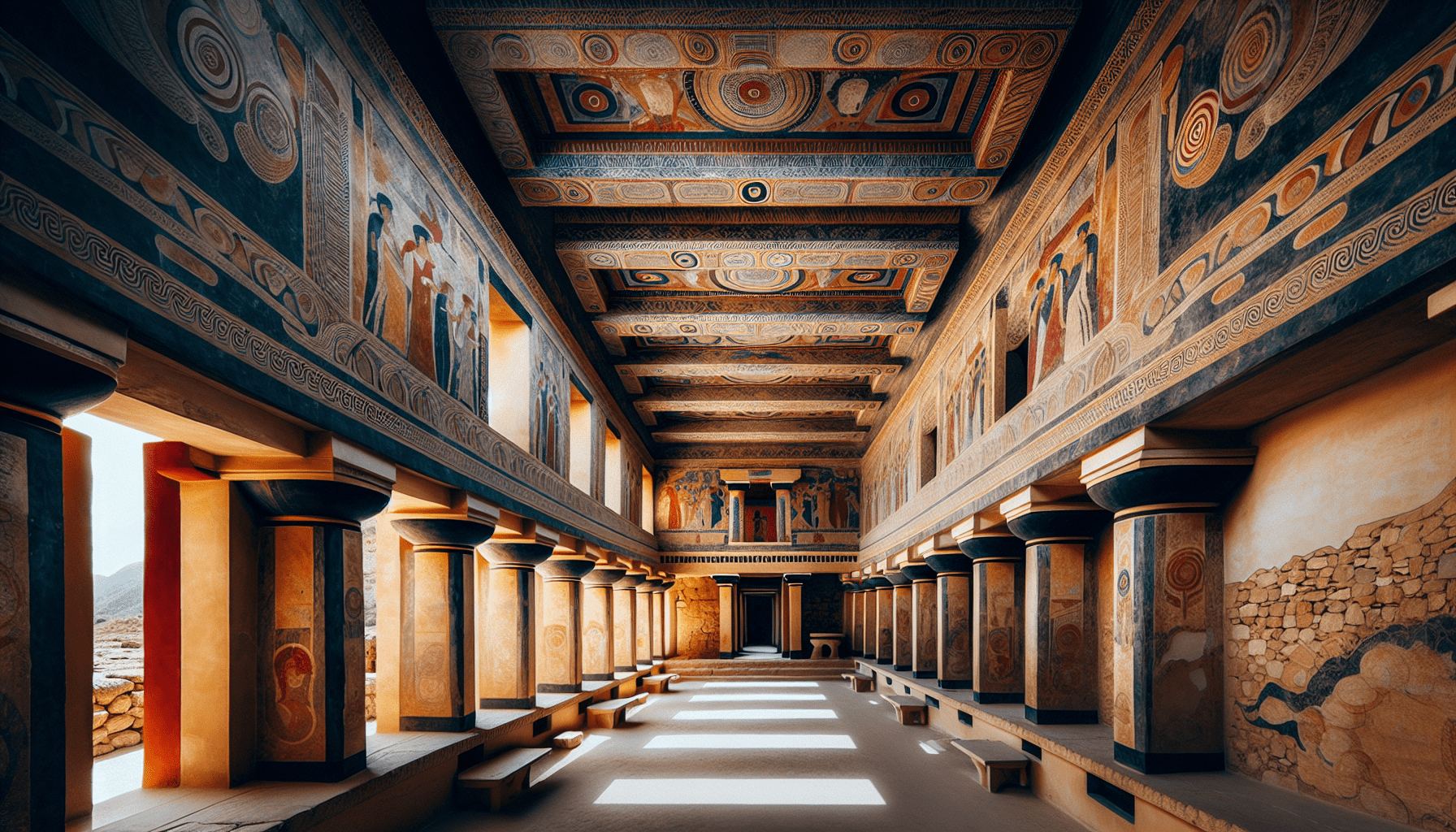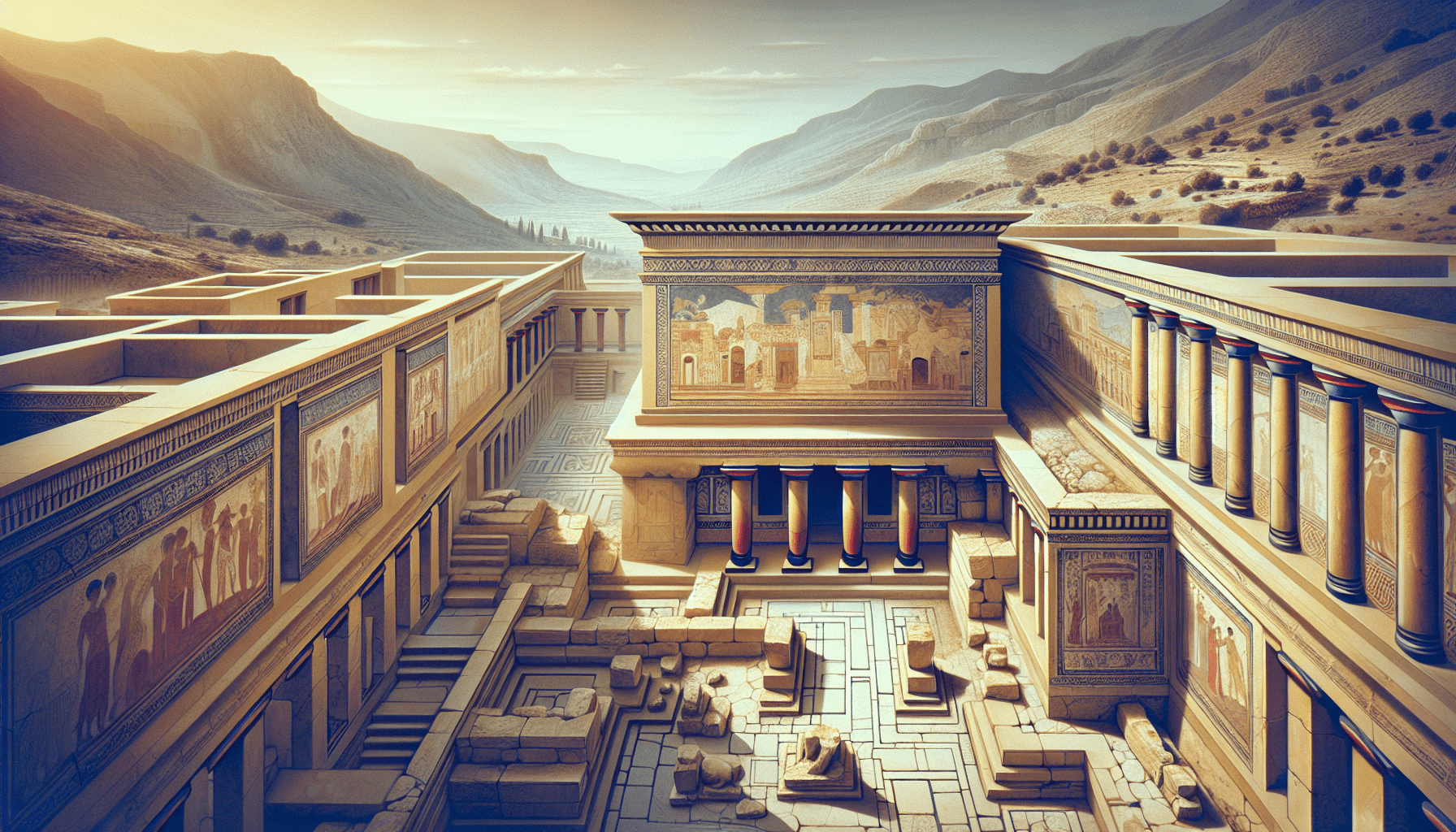BeautifyBeauties Spray Bottle For Hair – Continuous Mister Spray Bottle for Hairstyling, Cleaning, Plants, Pets, Barbers, Salons, Essential Oil Scents (10.1 Ounce)
$6.79 (as of January 8, 2025 23:29 GMT +00:00 - More info)Discovering the Minoan Palace of Knossos takes you on an enthralling journey through histories long past, revealing the cultural richness of the Greek Islands. You’ll find yourself enchanted by the remnants of civilizations that once thrived, with the Minoan Palace at the heart of Crete’s ancient history dating back to the 7th millennium BC. As you explore the majestic ruins associated with Greek mythologies, you’ll uncover fragments of our earliest human past, compelling you to imagine daily life during the height of the Minoan civilization. Surround yourself with the notable historical artifacts and mesmerizing architectural remnants that stand as testaments to humanity’s persistent quest for progress and artistic expression.
Discovering the Minoan Palace of Knossos
Have you ever wondered about the stories behind ancient ruins and the cultures that left them behind? Exploring historical sites is like stepping into a time machine, offering glimpses into the past and insights into how past events have shaped our modern world.
Greece, with its numerous islands, holds a treasure trove of historical sites perfect for enriching your trips. Let’s dive into one of the most significant of these sites: the Minoan Palace of Knossos on Crete. We’ll also touch on other fascinating historical spots across the Greek islands to give you a broader perspective.

Search vacation packages & trips
Minoan Palace of Knossos, Crete
A Remarkable Archaeological Site
Knossos is one of Greece’s most important archaeological sites, dating back to the 7th millennium BC. The palace was central to the Minoan civilization, a culture known for its advanced architecture, vibrant frescoes, and sophisticated urban planning. Encompassing a labyrinthine complex, Knossos not only reflects the ingenuity of the Minoans but also gives life to many myths and legends.
Myths and Legends
Knossos is steeped in Greek mythology. The palace is famously associated with the legend of the Minotaur, a mythical creature that was half-man and half-bull. According to the myth, King Minos of Crete kept the Minotaur in a labyrinthine maze beneath the palace. This makes Knossos a fascinating blend of history and mythology, allowing you to walk through the corridors and imagine a world where gods and mortals intertwined.
Extensive Ruins and Artifacts
What sets Knossos apart are the extensive ruins and significant historical artifacts that have been uncovered. As you explore, you’ll find remnants of multi-storied buildings, advanced drainage systems, and vibrant frescoes depicting rituals and daily life. These artifacts provide invaluable insights into the Minoan way of life.
Ancient Thera, Santorini
Historical Overview
Ancient Thera is another incredible site located on the hill of Mesa Vouno on the island of Santorini. Inhabited from the 9th century BC until 725 AD, Thera offers a diverse array of ruins that tell a story of a rich and varied history.
Scenic Views and Archaeological Significance
One of the highlights of Ancient Thera is its scenic location, offering stunning views of the Aegean Sea. As you explore, you’ll come across ruins of theaters, marketplaces, and temples, each revealing different facets of ancient Greek life.
An Insight into Ancient Daily Life
The ruins at Thera give you an opportunity to witness the remnants of a city that was once bustling with activity. Whether it’s the remains of public buildings or personal homes, each structure provides a peek into the daily lives of its ancient inhabitants.
Palace of the Grand Master of the Knights of Rhodes, Rhodes
Historical Significance
The Palace of the Grand Master of the Knights of Rhodes is a medieval fortress built in the 14th century. It served various defensive roles over the centuries, making it a cornerstone of Rhodes’ history.
Architectural Styles
The palace is notable for its Gothic and Renaissance architectural styles, offering a visual feast for architecture enthusiasts. It’s a compelling site that combines grandeur with historical depth.
Experiencing Medieval History
Walking through the corridors of this palace is like stepping back into medieval times. The palace’s upkeep allows you to experience its splendor as it was meant to be seen, giving you a vivid sense of the past.
Top domestic vacation destinations
Temple of Apollo (Portara), Naxos
An Unfinished Masterpiece
The Temple of Apollo, also known as Portara, is an iconic site on the island of Naxos. This monumental marble doorway began construction in 530 BCE but was never completed.
Popular for Photography
Portara is especially popular at sunset for photography, offering breathtaking views that capture the imagination. As the sun dips below the horizon, the temple’s silhouette against the sky provides a perfect moment for timeless snapshots.
A Testament to Ancient Ambition
Despite its unfinished state, the Temple of Apollo stands as a testament to the ambitions of those who built it. It’s a compelling reminder of the grandeur that ancient civilizations aspired to achieve.
Achillion Palace, Corfu
Neoclassical Elegance
Achillion Palace is a neoclassical mansion built in the late 19th century. It was commissioned by Empress Elisabeth of Bavaria, also known as Sisi. The palace reflects her love for Greek culture and mythology.
Opulent Architecture and Gardens
The palace features opulent architecture, intricate gardens, and striking artwork, making it a stunning site to visit. Each element of the palace reflects a blend of neoclassical and romantic styles, offering a visual and cultural feast.
A Royal Retreat
Originally designed as a retreat for Empress Sisi, the palace offers a glimpse into the luxurious lifestyle of European royalty. It’s a tranquil escape that also serves as a window into the past.
Castle Agia Maura, Lefkada
Historical Overview
Castle Agia Maura, located on the island of Lefkada, is a medieval fortress from the 14th century. The castle’s strategic location made it vital for defense against invaders.
Venetian and Ottoman Influences
The fortress features architectural influences from its Venetian and Ottoman periods. These diverse styles add layers of historical richness to the site.
Strategic Significance
Castle Agia Maura’s strategic significance is evident from its robust design and commanding views. It’s a site that illustrates the military and political importance of fortifications in medieval times.

Temple of Dimitra, Naxos
Dedicated to Demeter
The Temple of Dimitra, dating back to 530-520 BC, is dedicated to Demeter, the ancient Greek goddess of agriculture. Located on the island of Naxos, this temple is an excellent example of Doric architecture.
Doric Architectural Style
The temple’s Doric style is characterized by simple yet powerful lines, giving it an imposing presence despite its age. This makes it a must-visit for those interested in ancient Greek architecture.
A Sacred Site
Visiting the Temple of Dimitra offers you a chance to connect with ancient religious practices and the reverence with which the Greeks approached their deities. It’s a serene place that invites contemplation and respect.
Venetian Fortress – Naoussa, Paros
Historical Significance
The Venetian Fortress in Naoussa, built in the 15th century, protected against pirates and invaders. This makes it a site filled with stories of battles and defenses.
Panoramic Views
One of the highlights of this fortress is the panoramic views it offers of Naoussa Bay. The vantage point provides you with sweeping views of the bay, making it a breathtaking spot for photography.
A Fortified Menace
Walking through the ruins, you can almost hear the clinks of armor and the shouts of ancient defenders. The fortress is an evocative site that brings medieval military history to life.
Windmills of Mykonos, Mykonos
Iconic Landmarks
The Windmills of Mykonos are iconic landmarks built from the 16th to the 20th centuries. Originally used for milling wheat, these windmills are now primarily a picturesque tourist attraction.
Picturesque Setting
Set against the backdrop of the sparkling Aegean Sea, the windmills offer a perfect spot for photography. Their white, cylindrical structures are instantly recognizable and have become a symbol of Mykonos.
Historical Utility
These windmills aren’t just pretty to look at; they also tell the story of Mykonos’ past. Used for milling grain, they played a crucial role in the island’s economy before the age of industrialization.
Castle of Saint George, Kefalonia
Historical Overview
The Castle of Saint George dates back to the 12th century and overlooks villages on the island of Kefalonia. Over the centuries, it has seen significant modifications, reflecting various historical periods.
A Watchful Guardian
Perched high on a hill, the castle offers commanding views of the surrounding area. This strategic position made it an excellent defensive structure.
Journey Through Time
Walking through this castle is like taking a journey through time. Each modification and extension reveals a different era, allowing you to see how needs and strategies evolved over centuries.
Lindos Acropolis, Rhodes
Ancient Origins
The Lindos Acropolis is a site that dates back to the 4th century BCE. Known for its temples and ancient walls, it’s a treasure trove of ancient Greek architecture and history.
Scenic Views
The acropolis offers stunning vistas of the surrounding sea and countryside. The scenic views add an extra layer of awe to the historical exploration.
Sacred Grounds
The Lindos Acropolis was once a sacred ground for worship and ceremonies. Today, it’s a place where you can feel the spiritual weight of ancient practices and beliefs.
Argassi Bridge, Zakynthos
Historical Significance
The Argassi Bridge, built in the 19th century, is a historic stone bridge located in Zakynthos. Known for its weathered stone arches, the bridge is a picturesque remnant of the past.
Scenic Setting
Set against a beautiful natural backdrop, the Argassi Bridge offers a charming and serene setting for visitors. It’s an ideal spot for quiet reflection and photography.
A Symbol of Endurance
Despite the wear and tear of time, the Argassi Bridge stands as a symbol of endurance. It’s a reminder of the engineering prowess and aesthetic sensibilities of past builders.
Conclusion: A Glimpse Into Greece’s Rich History
Each of these sites provides a unique window into Greece’s rich history and architectural heritage. From the ancient ruins of the Minoan civilization at Knossos to the medieval fortresses and neoclassical palaces, these places offer invaluable insights into the societies that built them.
Exploring these historical sites not only enriches your understanding of the past but also offers stunning natural and architectural beauty that continues to inspire awe today. Whether you’re a history buff, an architecture enthusiast, or simply someone who appreciates the beauty of ancient civilizations, these sites offer something truly special. So why wait? Dive into the fascinating history of the Greek islands and discover the stories that make them so extraordinary!





